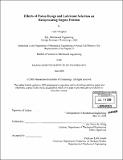| dc.contributor.advisor | Victor W. Wong. | en_US |
| dc.contributor.author | Moughon, Luke (Luke Frank) | en_US |
| dc.contributor.other | Massachusetts Institute of Technology. Dept. of Mechanical Engineering. | en_US |
| dc.date.accessioned | 2007-02-21T13:14:14Z | |
| dc.date.available | 2007-02-21T13:14:14Z | |
| dc.date.copyright | 2006 | en_US |
| dc.date.issued | 2006 | en_US |
| dc.identifier.uri | http://hdl.handle.net/1721.1/36247 | |
| dc.description | Thesis (S.M.)--Massachusetts Institute of Technology, Dept. of Mechanical Engineering, 2006. | en_US |
| dc.description | Includes bibliographical references (p. 99-101). | en_US |
| dc.description.abstract | The interaction between the piston and the liner in a reciprocating engine is of much interest because it affects reliability, noise, and efficiency. This study evaluated various changes to the piston skirt with the specific goal of minimizing friction. An analytical model of the piston, previously developed at MIT, was used to perform parametric studies of various designs in order to predict the effect of each on engine efficiency. The model incorporated hydrodynamic, boundary, and mixed lubrication modes, and it allowed for either fully-flooded or partially-flooded skirts. It also considered the effects of skirt deformation in response to applied loads. A dominant factor influencing net friction between the skirt and liner was the distribution between hydrodynamic lubrication (support by the oil film) and boundary lubrication (direct metal-to-metal contact). Design changes that shifted support from the high-friction boundary lubrication regime toward the hydrodynamic regime generally reduced net friction. For example, the model predicted that if a piston is originally supported largely by boundary contact, increasing the viscosity of the oil can reduce friction by enabling the oil film to sustain a greater load. If, however, the load is already supported primarily hydrodynamically, decreasing the viscosity reduces hydrodynamic drag and may reduce net friction. | en_US |
| dc.description.abstract | (cont.) Moreover, increasing oil supply (i.e., increasing effective oil film thickness) tends to decrease net friction by promoting hydrodynamic lubrication. Changes to piston geometry were shown to have significant effects on friction. In order to maximize hydrodynamic support, the pressure must be distributed evenly across the piston skirt; this can be achieved by making the skirt-liner clearance as even and smooth as possible. The model confirmed that skirt profiles with gentle slopes tend to reduce net friction, as do skirt ovality values that closely approximate the shape of the liner. Moreover, the grooves machined into the skirt surface were shown to have a deleterious effect on friction if their amplitude was large relative to the thickness of the oil film. Using relatively small-amplitude grooves facilitates oil movement and retention without leading to direct contact with the liner. After piston geometry has been optimized to promote hydrodynamic lubrication, further refinements, such as reducing oil viscosity, are possible. | en_US |
| dc.description.statementofresponsibility | by Luke Moughon. | en_US |
| dc.format.extent | 129 p. | en_US |
| dc.language.iso | eng | en_US |
| dc.publisher | Massachusetts Institute of Technology | en_US |
| dc.rights | M.I.T. theses are protected by copyright. They may be viewed from this source for any purpose, but reproduction or distribution in any format is prohibited without written permission. See provided URL for inquiries about permission. | en_US |
| dc.rights.uri | http://dspace.mit.edu/handle/1721.1/7582 | |
| dc.subject | Mechanical Engineering. | en_US |
| dc.title | Effects of piston design and lubricant selection on reciprocating engine friction | en_US |
| dc.type | Thesis | en_US |
| dc.description.degree | S.M. | en_US |
| dc.contributor.department | Massachusetts Institute of Technology. Department of Mechanical Engineering | |
| dc.identifier.oclc | 77275271 | en_US |
